The alchemists' ultimate goal was to transform common elements into the one, noblest element: gold. This metal was said to be unadulterated, stable, as genuine as the sun, a recurring view among alchemists. It is no coincidence that the sun (lat. sol) stands for the Planetary metal goldIt governs it, in it the secret of alchemy. The sun is the highest knowledge, the great mystery and also the most powerful symbol. The ability to create gold therefore also stands for the transformation of something seemingly impossible.
Spiritually, too, alchemy stands for the attempts to unite the limited with the unlimited, from impurity (nigredo) to enlightenment (albedo) to union with the divine (rubedo). Developed over time its own philosophy, that of hermeticism. The philosophy culminates in texts such as of the Tabula Smaragdinatwelve mysterious allegories about the nature of alchemy.
In "The Alchemist", Paulo Coelho has his protagonist go through many trials and tribulations before he finally realizes that he finds riches not in metals but in the divine. His becoming one with the divine is the final step to becoming a perfect alchemist.

The alchemist's work was always characterized by setbacks. Entire lifetimes and even generations were dedicated to the search for the secret recipe. Some claimed to have created gold, but often failed to provide proof. On their path, which was not always dedicated solely to gold, they found many reactions that opened the door to today's chemistry.
What does alchemy have to do with shaping organization?
No, it is not about luring people onto the wrong track. Like alchemy, shaping organization is the search for the secret path to perfection. And there are always those who claim to have found the formula. The philosopher's stone is first here, then there. Yesterday it was lean, today it is agile. If a company has enough contact with the philosopher's stone, it will be enlightened. At least that's what the legions of know-it-alls say.
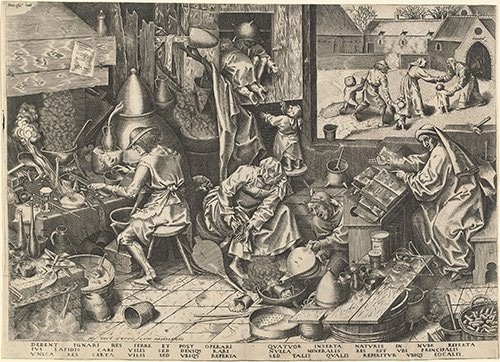
Ten sentences for better organizational design
Like the Tabula Smaragdina, this article compiles sentences for better organization. Unlike the Tabula Smaragdina, this article is not intended to be a guide to secret arts. Instead, the article is intended to set out the mental approaches that are necessary to shape and change organization.
Sentence 1: Organization is alive!
What is organization anyway? What is change?
In this article I asked who had ever seen an organization. The organization is often talked about almost as a matter of course, but it is never visible in its entirety. We only ever see the tip of the iceberg. We encounter events, decisions are made, artifacts are created. We interact with other people and increasingly with machines. All of this is organization.
And it is alive. Talking about ACTUAL or other states is always a human oversimplification. Sometimes it is helpful, sometimes not. It is important to be aware of this. While we are straining to look at the now, it is already over again.
What is more helpful instead is to look at what works in the long term. Certain patterns and dynamics last so long that it is worth analyzing (taking apart) and planning on the basis created in a realistic time frame. Changing dynamics will change future events. It is worth discovering these modes of action.
A concrete example: Teams are to be created in a company. A Scrum Master is to work in each team. So a number of Scrum Masters are advertised. In the meantime, the teams begin to work as such. Time and again, they reach their limits because they cannot decide some things. It becomes clear that Scrum Masters are not the greatest help, but rather the change in decision-making patterns, for example in the selection of suppliers.
Sentence 2: Organization is complex.
Although every organization is based on dynamics, a company cannot be described by a collection of all dynamics. Something is missing. Even if all the people, all the appointments, all the documents are collected together, the organization still cannot be described perfectly. Not even for the past.
The reason is the inherent complexity. Complexity means that companies are more than the sum of their parts. Sure, we can create images that tell us as much as possible, but they will never be perfect. And they convey a false sense of security that does not exist.
Likewise, there are no perfect solutions, no best cases. There is also no such thing as a completely wrong decision. Instead, there are certain patterns that are more likely based on experience.
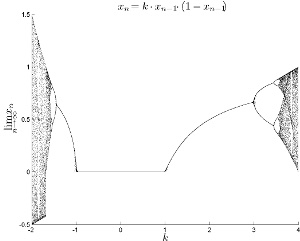
The so-called Fig tree diagram shows how for some values of k one solution of lim xn leads to one result (a line from left to right) and how for other values suddenly several (two or more) solutions (lim xn) exist for one k value.
Very practical: Never rely on best practices in the context of organization. Rather on bad practices and very skeptically on good practices. So the next time you have a change plan in front of you, be aware that it must be wrong! Just as optimal solutions are. Even the thought of whether something is optimal
Sentence 3: We think we know.
Unfortunately, we tend to think we know better. 88% of drivers surveyed believe they can drive better than 50% of drivers. We carry information around with us that we believe to be true. From this we derive how we want to act. Unfortunately, we know surprisingly little. The less we know, the less we notice.
Whenever you are sure, pause for a moment. Think carefully about what you are basing your judgment on. This is particularly important for organizational design, because you will not be working alone and a decision will affect several people.
Proposition 4: Personal realities are constructed.
Because organization in the corporate context means collaboration, several parties are involved. Colleagues, external parties, suppliers and so on. And everyone thinks they know something. We perceive the world around us and are tempted to believe that it is like this. But this is a fallacy, as can quickly be seen in any conversation.
A concrete example: It is 09:08. The appointment should start at 09:00. Three people have been there since 08:57. One is talking, two are waiting. Two more people join them now. Is that bad? Or normal? Depends on your personal truth. And even this can differ from day to day, not to mention cultural patterns.
Of course, there are truths that are more universal, for example, a company is almost always bound by employment law. The point is that change in particular addresses such personal aspects that the truths are just as personal.
It is therefore advisable to pay attention to viability and congruence and not to true/untrue. Viability is, in a broader sense, feasibility. If an organizational design is to be implemented/changed, the key people must be convinced of its feasibility. And if everyone (!) has the same picture in mind, the organizational design is also congruent. Good chances of success!
Theorem 5: Organizational change is mass psychology
In general, it is about creating psychological change not only in direct interaction but also for larger groups, even masses. This means that the habits of many people need to be changed. Mass psychology has sometimes been criticized for having served the great dictatorships of the 20th century, among others, or at least for having made itself all too useful. From Macchiavelli about Le Bon towards Zimbardo is the journey of well-known and criticized personalities.
In fact, recent experiments show that there are mass psychological phenomena. Surprisingly, these also paint a more benevolent picture of people. According to this, momentum counts for change. To a certain extent, credibility is attributed to people and less to content, as long as the latter remains sufficiently congruent. In this way, norms are created which are adapted and along which change takes place. This is why the underlying theory is also called Emergent Norm Theory. A few key figures are enough to trigger waves of change. The decisions of individuals multiply. These individuals must be aware of this. This blessing can also be a curse.
Unfortunately, I well remember a release train engineer, a moderator for the big planning event with over 120 participants. Various difficulties were brought to his attention. In the end, he changed the agenda by a few hours at short notice, with the effect that all subsequent appointments had to be postponed even weeks later.
The takeaway from this anecdote is that not everyone has to be enthusiastic; decisions that are criticized are also part of the process. In fact, it often seems to be the nature of every change that it is met with rejection. Not a bad sign.
Last but not least, simple communication is particularly important when dealing with crowds, the fourth sentence comes into its own, everyone understands what is said a little differently. Constant repetition of even the clearest images (for example a guiding principle) helps to create congruence in the group.
Sentence 6: Without action, all thinking is nothing.
Thinking and talking are not enough. There is the frequent problem that all kinds of plans are made. And then nothing happens. Or that plans are made and something else happens. These undesirable outcomes are the result of inaction.
"It's not enough to know - you also have to apply it.
Johann Wolfgang von Goethe
It's not enough to want - you also have to do it. "
Every plan must be implemented. The great advantage of agile working is that iteration and incrementation promote constant, proactive action.
Sentence 7: Fallibility is necessary
The previous sentence and this one go hand in hand. Action is necessary and failure is possible. So fallibility is necessarily part of action.
Fail fast, fail often; has become a fixed term. It implies the ability to adapt and avoid sunk costs. Clever failure is therefore also advisable from an organizational and entrepreneurial perspective. Eric Ries, for example, describes in his book Lean Startuphow start-ups and established companies are working with this idea.
It is easier to learn from these mistakes than from measuring sticks that are too low and yet are repeatedly skipped. In this article, I have described how helpful errors are in the introduction of the Scaled Agile Framework (SAFe).
Sentence 8: Adaptation is permanent
There is no such thing as finished. You can already hear it in sentences one and two. Because there is no such thing as the optimum, but always situations that change, permanent adaptation is necessary.
This is actually obvious. Evolution doesn't just stop or is only carried out in two-year intervals. No, dear frog, there is no adaptation to the environment in even years. And yet this is exactly what happens time and again in companies.
Behind this is a way of thinking:
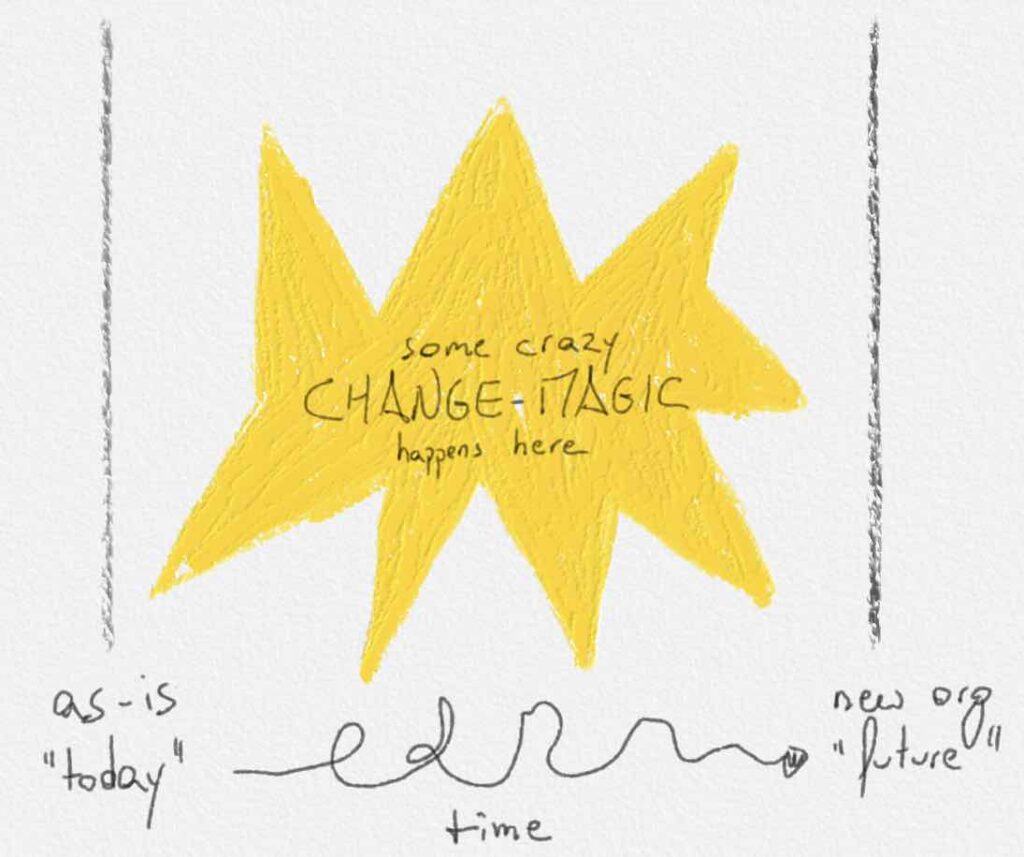
The image can be translated as follows: Today is not good. That's why we have to change something. We paint a picture of what the organization should look like in the future. And then we decide how to implement it. That is the change.
Now I've heard people (including colleagues) say that we need to change this! I agree with that. We have to put change at the center. I only partially agree with that. The following picture would emerge:
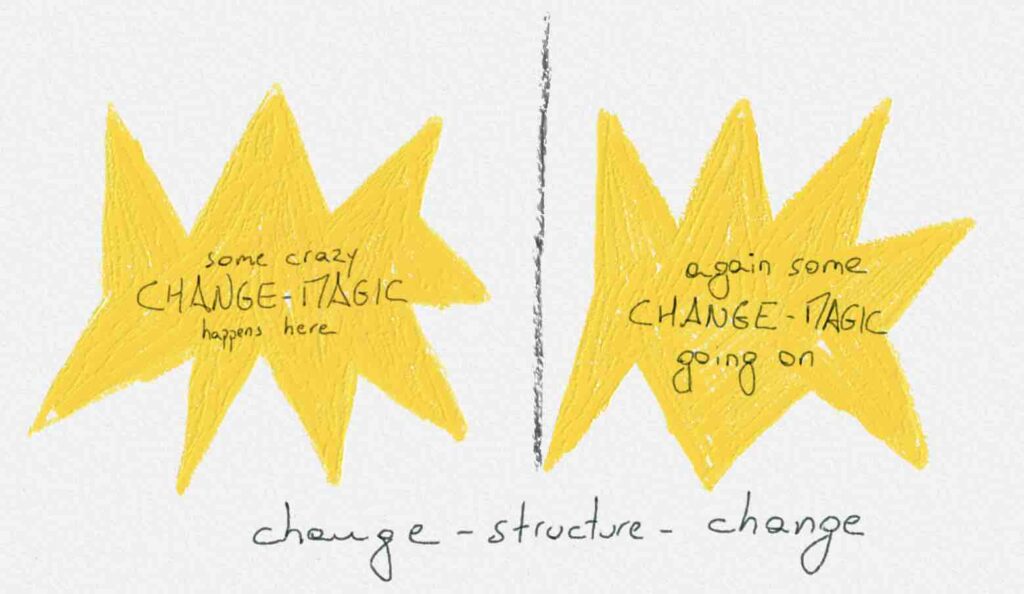
Let's call this approach "change-structure-change". After all, evolution is now permanently available to the frog again. Lucky you, little frog. But if we take a closer look, we notice another man-made simplification: There is a stable state in the middle. Well, it can last ten years or a week. But this state is misleading. Most likely, precisely because so many actors with overlapping dynamics interact in a complex environment, this state will not exist. In other words: panta rhei; everything flows.
Organizational design that takes this into account therefore requires an approach that supports panta rhei. Fortunately, there is something.

This approach is evolutionary in several respects. On the one hand, Jason Little uses the Lean change management many references that exist in theory and practice on change. On the other hand, the approach is inherently evolutionary in that change is carried out continuously in feedback loops.
Sentence 9: The most important thing is to survive
What is the most important thing for a company?
Yes, earning money. But is that it? Yes. But not only. Because there may be times when companies decide to go into negative cash flow in order to buy growth. This is a common tactic used by companies in expanding markets. By growing faster than competitors, economies of scale can be achieved and market barriers erected. Both help to secure later margins that would be higher than today's profits. If you would like to read more about this and can reflect critically, I recommend the book "From Zero to One". In the VC scene, there is the term cash burn rate, which indicates how much (VC) capital a company currently needs per unit of time, i.e. by when it must be profitable with its current capital.
If it's not unreservedly "making money", then what is it? Well in the long run, and the family businesses and dynasties may agree, it is simply survival.
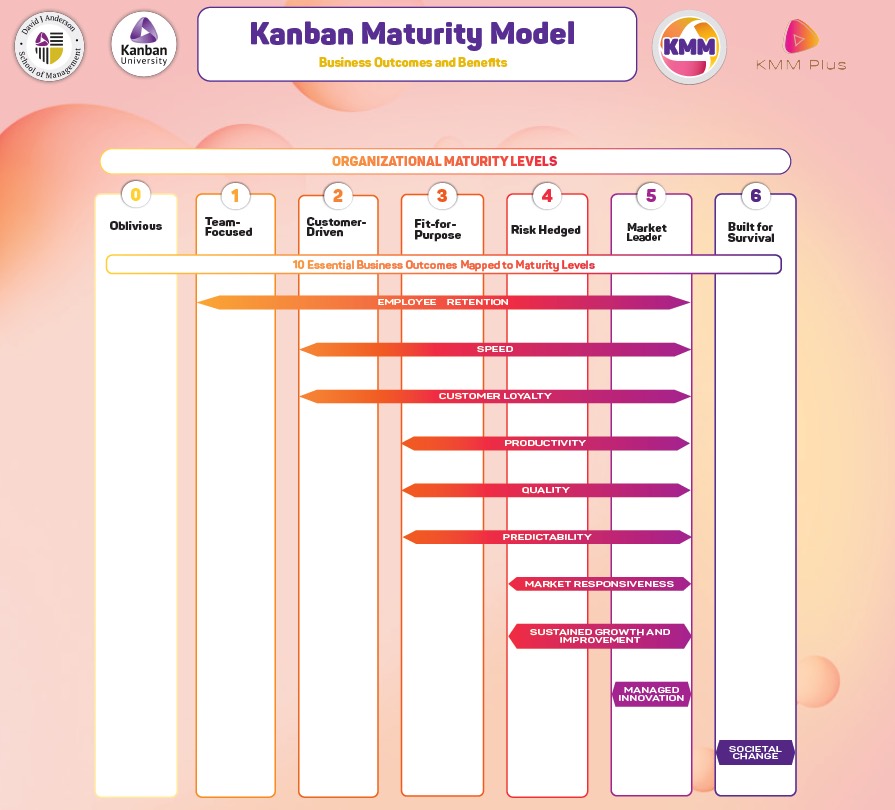
From the Kanban University, namely by Anna Radzikowska and David Anderson there is a matching concept. They describe maturity levels for companies and the highest is survival; I think the picture above is self-explanatory. If you want to know more about this, I recommend the amazingly readable book Fit for Purpose by David Anderson and Alexei Zheglov.
With all change, the focus should be on what it is for. I've spoken to a number of decision-makers and an astonishing number of them can't give a convincing answer to the question of why they want to introduce agile working. This ties in with sentence 5 and speaks volumes for the strategy. Anyone who cannot say what an organization should focus on is unlikely to have a strategy that sets a clear enough direction. Should the company become more attractive to employees? Faster in market expansion? Better in terms of service quality? More visible development progress? More resilient to product changes?
If the answer is always Scrum, then perhaps there is only one unsuitable hammer.
It also follows that there can be no blueprints. How did company xy do it? Sure, if I know (or at least believe, see sentences 3 and 4), I can already give the answer. It's just probably not appropriate. That's why the "Spotify approach", for example, is inappropriate. Incidentally, Spotify itself has long since moved away from this, but some know-it-all out there is still selling this "model". And someone is buying it; grrrr!
Sentence 10: Emotions are decisive
Anyone who has read this far and thinks: "I get it, I now know how organizational design and change works" should pause. Take a quick look at
Think back to sentence 3. And then think again very, very slowly. What is it that moves us humans the most? The mind? Of course.
While the mind tends to reside in the prefrontal cortex, acting out of emotion tends to be located in the amygdala. Take a look at the pictures: The amygdala (there are usually two) tends to be located in the middle of these pictures, the cortex at the top. The rest is clear.
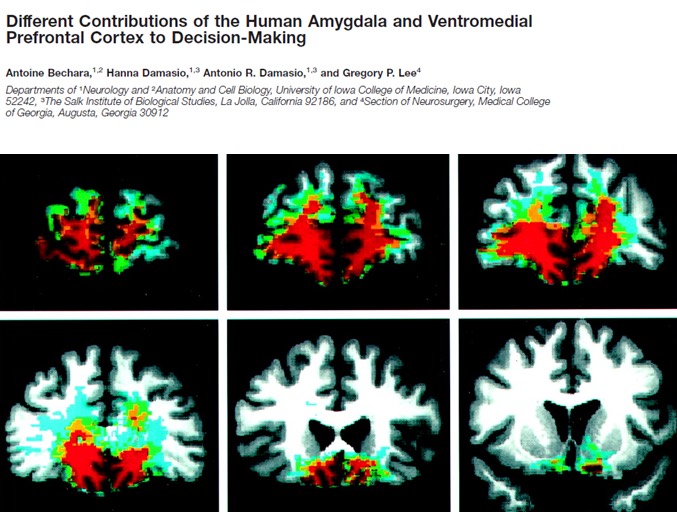
One of the authors himself may draw the conclusion:
We are not thinking machines that feel, we are feeling machines that think.
António R. Damásio
In everything you do now, be aware that you and I all act more out of emotion than reason. And more than we know, even more than we believe!
Turn it to eleven!
Of course, there are many more sentences and many people who are far smarter, more involved or have worked scientifically on the subject. All these findings still apply. Presumably, and I make this humility explicit here, my sentences are not sufficient, not complete and perhaps they do not even fulfill what is necessary to explain organizational design.
So two questions for you: What would you change? And what would you add?


Write a comment